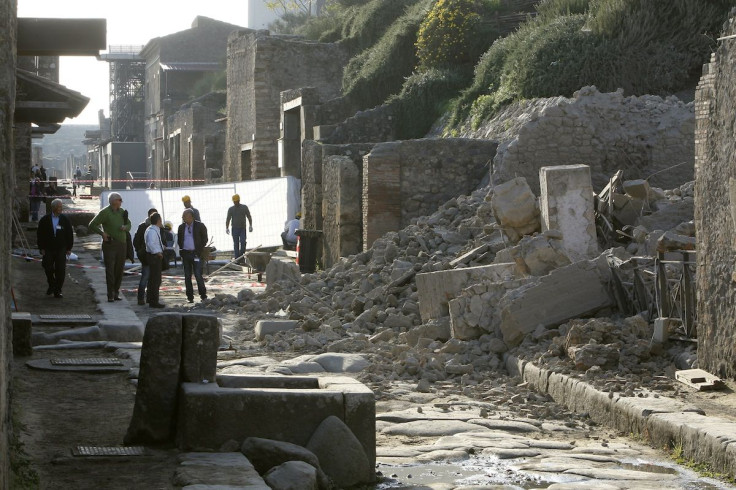Collapses At Pompeii Highlight Poor State Of World Heritage Icon

Is it simply a case of bad weather or have decades of mismanagement left the UNESCO World Heritage site of Pompeii crumbling at the core? That’s a question many are asking after two new collapses over the weekend damaged the ancient Roman city, which was buried by an eruption at Mount Vesuvius in 79 AD. until its impeccably preserved streets remerged from excavation in 1748.
Heavy rains on Saturday sent masonry on a support arch at the Temple of Venus tumbling to the ground. Then on Sunday, a tomb in the Porta Nocera cemetery caved in, according to local reports, prompting Italy’s culture minister to demand an explanation in an “emergency meeting” with officials responsible for the site. The collapses, after all, were nothing new.
A collapse at the frescoed House of Gladiators in 2010 was, perhaps, the first to sound the alarm on the issue. Conservation work to repair the damage only began last February after a 105 million euro cash injection, partly funded by the EU, known as the Great Pompeii Project.
A series of subsequent collapses -- the most recent of which occurred in December -- sparked international outcry over the neglect of one of the world’s most iconic archeological sites. UNESCO, which now orders Italian officials to prepare annual progress reports, warned last year that “the lack of guardians and technicians for basic management, supervision and maintenance of the site continues to be a problem at the property.”
Some of the steps to remedy the problem are quite simple, according to Maria Pia Guermandi, a Pompeii expert with heritage group Italia Nostra. She told the Telegraph that day-to-day, low cost maintenance like clearing drainage channels could prevent the site from becoming waterlogged.
“The EU money is being focused on the restoration of a few important houses, but Pompeii doesn’t need expert restorers, it needs workmen who can provide daily maintenance. These two new collapses [over the weekend] show the situation is still out of control.”
Guermandi added that Pompeii, near modern day Naples, risks loosing some of its emergency EU cash. “The money needs to be spent by 2015 or funding will be withdrawn, yet only about 10 million has been used and things have been slowed down by in-fighting at the ministry of culture,” she said.
Beyond maintenance, some of Pompeii’s issues may be harder to address. “Having millions of visitors just stamping around Pompeii or Venice each year causes its own destruction,” Clementina Panella, an archeologist at Rome’s La Sapienza University, told the Independent. “Tourists need to be directed to other less-known places.”
That seems rather unlikely following the release of the Hollywood blockbuster “Pompeii,” which opened in the U.S. two weeks ago and rolled out to 30 more countries over the weekend as the real Pompeii crumbled.
Officials expect the number of stone-trampling visitors to swell beyond the current annual average of 2.3 million to 2.6 million by 2017, thanks to both the film and the reopening of previously closed-off sections of the property.
To date, archeologists have uncovered roughly two-thirds of the 165-acre town, which housed about 13,000 people before it was buried under ash and pumice in an eruption scientists say was equivalent to 40 atomic bombs. Panella said that if the park was managed intelligently, it could generate the same amount of income it currently receives with fewer visitors.
© Copyright IBTimes 2024. All rights reserved.






















